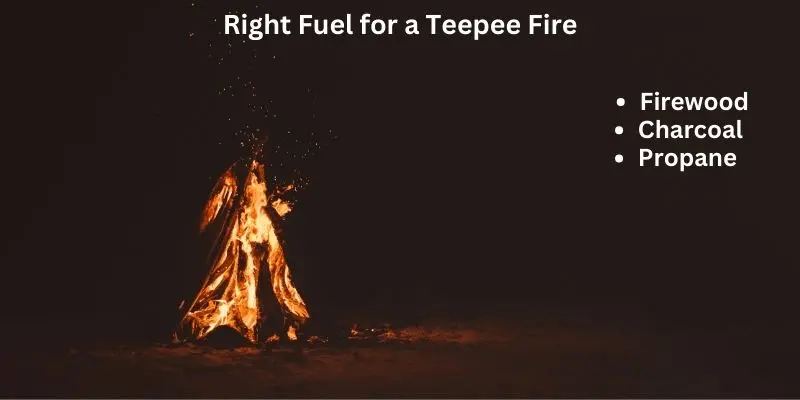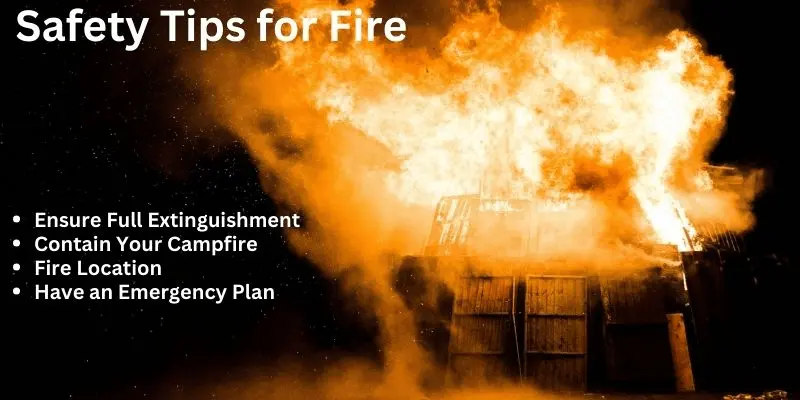Choosing the Right Fuel for a Teepee Fire: Essential Tips & Safety Measures | #1 Campfire Guide
Updated: 27 Jan 2024
234
When it comes to enjoying an evening under the stars, a properly lit teepee fire can be your best companion. However, choosing the Right Fuel for a Teepee Fire is crucial for both the warmth of your fire and the safety of your surroundings. Here’s how to choose the best fuel for your teepee fire, and some essential safety pointers.
Picking the right stuff to burn in a teepee fire is important for making a good fire outside. A teepee fire is when you stack the wood in a cone shape, like the tents Native Americans used to have. To keep the fire going strong and lasting a long time, it’s important to use wood that’s dry and has been seasoned.
Good choices are hardwoods like oak, maple, or hickory because they burn slowly and make a steady fire. Stay away from wood that’s still green or wet because it can make too much smoke and make it hard to keep the fire steady. You can also use small things like twigs or dry leaves to start the fire.
If you pick the right mix of fuel, your teepee fire will give off warmth and make a nice atmosphere for outdoor get-togethers.
Types of Fuel
There are various types of fuel you can choose from for your teepee fire. Each has its unique characteristics and provides different benefits when used in a campfire. It’s essential to understand the difference between them to make the best choice for your next camping trip.

1. Firewood
Firewood is perhaps the most commonly used fuel for a teepee fire. It comes in different types and sizes, such as hardwoods like oak or softwoods like pine. The type of wood used can affect the color, smell, and burn time of your fire.
2. Charcoal
Charcoal is another popular option for campfires as it burns longer and produces less smoke than firewood. This makes it a great choice for cooking food over a campfire. However, it’s essential to use lump charcoal instead of briquettes as the latter can contain toxic chemicals that are harmful to both humans and the environment.
3. Propane
Propane is a clean-burning fuel that is commonly used in outdoor fire pits and grills. It’s easy to use, doesn’t produce sparks or embers, and can be turned off instantly. However, it may not provide the same cozy atmosphere as a traditional teepee fire.
Selecting the Right Fuel
When choosing the right fuel for your teepee fire, consider your needs and preferences. Are you looking for warmth, ambiance, or cooking capabilities? Here are some factors to keep in mind:
- Heat Output: Different fuels produce different levels of heat, so consider the temperature and weather conditions when selecting your fuel.
- Burn Time: If you’re planning to stay out for a while, choose a fuel that burns longer to avoid constantly having to add more wood or charcoal.
- Safety: It’s crucial to prioritize safety when choosing your fuel. Consider factors such as sparks, embers, and potentially toxic chemicals.
Pros and cons of Right Fuel for a Teepee Fire
| Pros |
|---|
|
| Cons |
|---|
|
Overall, choosing the right fuel for a teepee fire requires careful consideration of factors such as heat output, burn time, and safety. By understanding the different types of fuel available and following essential safety tips, you can ensure a safe and enjoyable campfire experience.
Comparison table between the Right Fuel for a Teepee Fire and a Traditional Fire
The below comparison table highlights the key differences between using the right fuel for a teepee fire and a traditional fire, considering factors such as Safety, Heat Output, burn Time, Cooking Capabilities, Availability, and Control and Extinguishing.
| Aspect | Right Fuel for a Teepee Fire | Traditional Fire |
| Safety | May produce sparks or embers in dry conditions, potential release of toxic chemicals | Reduced risk of sparks and embers, but may still pose a safety hazard if not managed properly |
| Heat Output | Varies depending on the type of fuel used | Generally provides a consistent level of heat |
| Burn Time | Can vary depending on the type of fuel used, but can burn for extended periods if chosen carefully | May require frequent addition of wood or other materials to maintain the fire |
| Cooking Capabilities | Can be used for cooking food over the fire, especially with charcoal | Limited ability to cook food directly on the fire |
| Availability | Can be found in various types and sizes to suit individual preferences | May be limited to certain types of wood or materials available in the surrounding area |
| Control and Extinguishing | Can be challenging to control or extinguish in windy conditions | Easier to control and extinguish with proper management |
Safety First: Tips and Precautions
Safety is of utmost importance when it comes to various activities, and it’s no exception when dealing with fire or potentially hazardous situations. Here are some essential tips and precautions to ensure a safe environment:

- Ensure Full Extinguishment before Leaving
One of the most important safety practices is to ensure your teepee fire is fully extinguished before leaving the area. This means that the fire should be out, cold to the touch, and wet.
- Contain Your Campfire
A fire ring or fire pit is a must to keep your teepee fire contained and prevent it from spreading. If neither is available, clear the area of combustibles down to the soil and create a small mound or ring of rocks to contain the fire.
- Location, Location, Location
Select your teepee fire location carefully. Ensure it’s away from overhanging branches, dry grass, and your tent or other camping gear. A good rule of thumb is to place it where you’d like to least expect embers to travel.
- Have an Emergency Plan
Have a bucket of water nearby or a fire extinguisher ready to use in case the fire starts to get out of control. It’s better to be over-prepared than to risk a fire that you can’t readily extinguish.
- Green, Wet Wood Is a “No Go”
Do not use green wood or wood you suspect is wet. They not only make it difficult to maintain a fire but also generate more smoke and creosote, which can build up in your chimney over time and pose a fire hazard. Always use dry, seasoned wood for your teepee fire.
FAQS
What if I can’t find any hardwoods for my teepee fire?
If you’re unable to source hardwoods, you can also use softwoods such as pine or cedar. However, keep in mind that these woods burn faster and may not provide the same long-lasting warmth and aroma as hardwoods.
Is it safe to use gasoline or other accelerants to start a teepee fire?
No, it is not safe to use gasoline or any other accelerants in your teepee fire. This can cause the fire to get out of control and potentially harm you and your surroundings. Stick to using dry, seasoned wood and kindling for a safe and enjoyable teepee fire experience.
How often should I check on my teepee fire?
It’s important to constantly monitor your teepee fire and make sure it stays contained. Check on it every 30 minutes or so and always make sure to fully extinguish it before leaving the area.
Can I roast marshmallows over a teepee fire?
Yes, you can roast marshmallows or any other food over a teepee fire, as long as you use non-toxic skewers and follow proper safety precautions. Never leave your food unattended near the fire and always supervise children around the fire.
Conclusion
As you can see, both the Right Fuel for a Teepee Fire and a traditional fire has their own unique advantages and drawbacks. It ultimately comes down to personal preference and careful consideration of safety when choosing the best fuel for your teepee fire.
So next time you’re planning a camping trip, remember to select the right fuel for your teepee fire and enjoy the warmth and coziness of a well-lit fire under the stars. No matter which type of fuel you choose, with proper care and precautions, it can provide the perfect ambiance for a memorable camping experience.
So go ahead, gather some wood or charcoal, and enjoy an evening by the campfire under the stars!
Please Write Your Comments